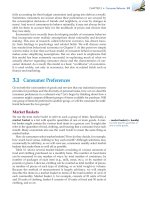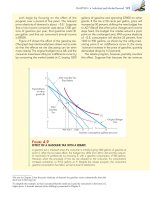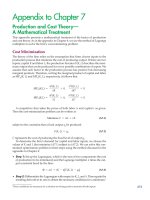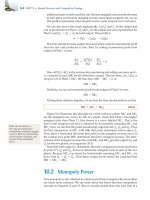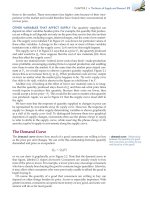(8th edition) (the pearson series in economics) robert pindyck, daniel rubinfeld microecon 258
Bạn đang xem bản rút gọn của tài liệu. Xem và tải ngay bản đầy đủ của tài liệu tại đây (81.74 KB, 1 trang )
CHAPTER 7 • The Cost of Production 233
lakeshore location is high: That property could have
been sold for enough money to buy the Evanston
land with substantial funds left over.
In the end, Northwestern decided to keep the
law school in Chicago. This was a costly deci-
sion. It may have been appropriate if the Chicago
location was particularly valuable to the law
school, but it was inappropriate if it was made
on the presumption that the downtown land had
no cost.
Fixed Costs and Variable Costs
Some costs vary with output, while others remain unchanged as long as the
firm is producing any output at all. This distinction will be important when we
examine the firm’s profit-maximizing choice of output in the next chapter. We
therefore divide total cost (TC or C)—the total economic cost of production—
into two components.
• Fixed cost (FC): A cost that does not vary with the level of output and that can
be eliminated only by going out of business.
• Variable cost (VC): A cost that varies as output varies.
Depending on circumstances, fixed costs may include expenditures for plant
maintenance, insurance, heat and electricity, and perhaps a minimal number of
employees. They remain the same no matter how much output the firm produces. Variable costs, which include expenditures for wages, salaries, and raw
materials used for production, increase as output increases.
Fixed cost does not vary with the level of output—it must be paid even if
there is no output. The only way that a firm can eliminate its fixed costs is by shutting
down.
SHUTTING DOWN Shutting down doesn’t necessarily mean going out of business. Suppose a clothing company owns several factories, is experiencing declining demand, and wants to reduce output and costs as much as possible at one
factory. By reducing the output of that factory to zero, the company could eliminate the costs of raw materials and much of the labor, but it would still incur
the fixed costs of paying the factory’s managers, security guards, and ongoing
maintenance. The only way to eliminate those fixed costs would be to close the
doors, turn off the electricity, and perhaps even sell off or scrap the machinery.
The company would still remain in business and could operate its remaining
factories. It might even be able to re-open the factory it had closed, although
doing so could be costly if it involved buying new machinery or refurbishing
the old machinery.
FIXED OR VARIABLE? How do we know which costs are fixed and which are
variable? The answer depends on the time horizon that we are considering.
Over a very short time horizon—say, a few months—most costs are fixed. Over
such a short period, a firm is usually obligated to pay for contracted shipments
of materials and cannot easily lay off workers, no matter how much or how little
the firm produces.
On the other hand, over a longer time period—say, two or three years—many
costs become variable. Over this time horizon, if the firm wants to reduce its
output, it can reduce its workforce, purchase fewer raw materials, and perhaps
even sell off some of its machinery. Over a very long time horizon—say, ten
• total cost (TC or C) Total
economic cost of production,
consisting of fixed and variable
costs.
• fixed cost (FC) Cost that
does not vary with the level
of output and that can be
eliminated only by shutting
down.
• variable cost (VC) Cost that
varies as output varies.

